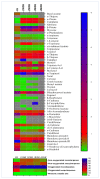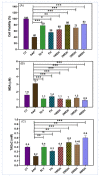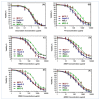Sage, Salvia officinalis L., Constituents, Hepatoprotective Activity, and Cytotoxicity Evaluations of the Essential Oils Obtained from Fresh and Differently Timed Dried Herbs: A Comparative Analysis
- PMID: 34641301
- PMCID: PMC8510068
- DOI: 10.3390/molecules26195757
Sage, Salvia officinalis L., Constituents, Hepatoprotective Activity, and Cytotoxicity Evaluations of the Essential Oils Obtained from Fresh and Differently Timed Dried Herbs: A Comparative Analysis
Abstract
Sage, Salvia officinalis L., is used worldwide as an aromatic herb for culinary purposes as well as a traditional medicinal agent for various ailments. Current investigations exhibited the effects of extended dryings of the herb on the yields, composition, oil quality, and hepatoprotective as well as anti-cancer biological activities of the hydrodistillation-obtained essential oils from the aerial parts of the plant. The essential oils' yields, compositions, and biological activities levels of the fresh and differently timed and room-temperature dried herbs differed significantly. The lowest yields of the essential oil were obtained from the fresh herbs (FH, 631 mg, 0.16%), while the highest yield was obtained from the two-week dried herbs (2WDH, 1102 mg, 0.28%). A notable decrease in monoterpenes, with increment in the sesquiterpene constituents, was observed for the FH-based essential oil as compared to all the other batches of the essential oils obtained from the different-timed dried herbs. Additionally, characteristic chemotypic constituents of sage, i.e., α-pinene, camphene, β-pinene, myrcene, 1, 8-cineole, α-thujone, and camphor, were present in significantly higher proportions in all the dried herbs' essential oils as compared to the FH-based essential oil. The in vivo hepatoprotective activity demonstrated significant reductions in the levels of AST, ALT, and ALP, as well as a significant increase in the total protein (p < 0.05) contents level, as compared to the acetaminophen (AAP) administered experimental group of rats. A significant reduction (p < 0.05) in the ALT level was demonstrated by the 4WDH-based essential oil in comparison to the FH-based essential oil. The levels of creatinine, cholesterol, and triglycerides were reduced (p < 0.05) in the pre-treated rats by the essential oil batches, with non-significant differences found among them as a result of the herbs dryings based oils. A notable increase in the viability of the cells, and total antioxidant capacity (TAOxC) levels, together with the reduction in malondialdehyde (MDA) levels were observed by the essential oils obtained from all the batches as compared with the AAP-treated cell-lines, HepG-2, HeLa, and MCF-7, that indicated the in vitro hepatoprotective effects of the sage essential oils. However, significant improvements in the in vivo and in vitro hepatoprotective activities with the 4WDH-based oil, as compared to all other essential oil-batches and silymarin standard demonstrated the beneficial effects of the drying protocol for the herb for its medicinal purposes.
Keywords: HeLA cells; HepG-2 cells; MCF-7; MDA; Sage; Salvia officinalis; TAOxC; cytotoxicity; hepatoprotection.
Conflict of interest statement
The authors declare no conflict of interest.
Figures




Similar articles
-
Drying Induced Impact on Composition and Oil Quality of Rosemary Herb, Rosmarinus Officinalis Linn.Molecules. 2020 Jun 19;25(12):2830. doi: 10.3390/molecules25122830. Molecules. 2020. PMID: 32575415 Free PMC article.
-
Composition of the essential oil of Salvia officinalis L. from various European countries.Nat Prod Res. 2007 May;21(5):406-11. doi: 10.1080/14786410500528478. Nat Prod Res. 2007. PMID: 17487611
-
Essential oils produced by in vitro shoots of sage (Salvia officinalis L.).J Agric Food Chem. 2003 Apr 9;51(8):2260-6. doi: 10.1021/jf020945v. J Agric Food Chem. 2003. PMID: 12670167
-
Aromatic Herbs as a Source of Bioactive Compounds: An Overview of Their Antioxidant Capacity, Antimicrobial Activity, and Major Applications.Molecules. 2025 Mar 14;30(6):1304. doi: 10.3390/molecules30061304. Molecules. 2025. PMID: 40142079 Free PMC article. Review.
-
Back to the Roots-An Overview of the Chemical Composition and Bioactivity of Selected Root-Essential Oils.Molecules. 2021 May 25;26(11):3155. doi: 10.3390/molecules26113155. Molecules. 2021. PMID: 34070487 Free PMC article. Review.
Cited by
-
Antioxidative and Anti-Inflammatory Protective Effects of Fucoxanthin against Paracetamol-Induced Hepatotoxicity in Rats.Mar Drugs. 2023 Nov 14;21(11):592. doi: 10.3390/md21110592. Mar Drugs. 2023. PMID: 37999416 Free PMC article.
-
Bioactivity and Nanoformulation of Essential Oils: Implications for Antioxidant and Anti-inflammatory Applications.ACS Omega. 2025 Jun 19;10(25):26729-26742. doi: 10.1021/acsomega.5c01246. eCollection 2025 Jul 1. ACS Omega. 2025. PMID: 40621039 Free PMC article.
-
Bio-Evaluation of the Wound Healing Activity of Artemisia judaica L. as Part of the Plant's Use in Traditional Medicine; Phytochemical, Antioxidant, Anti-Inflammatory, and Antibiofilm Properties of the Plant's Essential Oils.Antioxidants (Basel). 2022 Feb 8;11(2):332. doi: 10.3390/antiox11020332. Antioxidants (Basel). 2022. PMID: 35204215 Free PMC article.
-
Editorial: Biosynthesis, purification, characterization and uses of natural compounds in plants.Front Plant Sci. 2023 Jul 6;14:1162676. doi: 10.3389/fpls.2023.1162676. eCollection 2023. Front Plant Sci. 2023. PMID: 37484475 Free PMC article. No abstract available.
-
Sub-chronic and acute toxicity of aqueous extracts Salvia blancoana subsp. mesatlantica (Maire) Figuerola to rodents.Toxicol Rep. 2024 Nov 30;13:101847. doi: 10.1016/j.toxrep.2024.101847. eCollection 2024 Dec. Toxicol Rep. 2024. PMID: 39703767 Free PMC article.
References
-
- Sharifi-Rad M., Ozcelik B., Altın G., Daşkaya-Dikmen C., Martorell M., Ramírez-Alarcón K., Alarcón-Zapata P., Morais-Braga M.F.B., Carneiro J.N.P., Leal A.L.A.B. Salvia spp. plants-from farm to food applications and phytopharmacotherapy. Trends Food Sci. Technol. 2018;80:242–263.
-
- Adams M., Gmünder F., Hamburger M. Plants traditionally used in age-related brain disorders—A survey of ethnobotanical literature. J. Ethnopharmacol. 2007;113:363–381. - PubMed
-
- Perry E.K., Pickering A.T., Wang W.W., Houghton P.J., Perry N.S.L. Medicinal plants and Alzheimer’s disease: From ethnobotany to phytotherapy. J. Pharm. Pharmacol. 1999;51:527–534. - PubMed
Publication types
MeSH terms
Substances
Grants and funding
LinkOut - more resources
Full Text Sources
Miscellaneous

